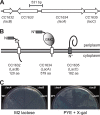Identification of a dehydrogenase required for lactose metabolism in Caulobacter crescentus
- PMID: 20190087
- PMCID: PMC2863468
- DOI: 10.1128/AEM.02085-09
Identification of a dehydrogenase required for lactose metabolism in Caulobacter crescentus
Abstract
Caulobacter crescentus, which thrives in freshwater environments with low nutrient levels, serves as a model system for studying bacterial cell cycle regulation and organelle development. We examined its ability to utilize lactose (i) to gain insight into the metabolic capacities of oligotrophic bacteria and (ii) to obtain an additional genetic tool for studying this model organism, aiming to eliminate the basal enzymatic activity that hydrolyzes the chromogenic substrate 5-bromo-4-chloro-3-indolyl-beta-d-galactopyranoside (X-gal). Using a previously isolated transposon mutant, we identified a gene, lacA, that is required for growth on lactose as the sole carbon source and for turning colonies blue in the presence of X-gal. LacA, which contains a glucose-methanol-choline (GMC) oxidoreductase domain, has homology to the flavin subunit of Pectobacterium cypripedii's gluconate dehydrogenase. Sequence comparisons indicated that two genes near lacA, lacB and lacC, encode the other subunits of the membrane-bound dehydrogenase. In addition to lactose, all three lac genes are involved in the catabolism of three other beta-galactosides (lactulose, lactitol, and methyl-beta-d-galactoside) and two glucosides (salicin and trehalose). Dehydrogenase assays confirmed that the lac gene products oxidize lactose, salicin, and trehalose. This enzymatic activity is inducible, and increased lac expression in the presence of lactose and salicin likely contributes to the induction. Expression of lacA also depends on the presence of the lac genes, implying that the dehydrogenase participates in induction. The involvement of a dehydrogenase suggests that degradation of lactose and other sugars in C. crescentus may resemble a proposed pathway in Agrobacterium tumefaciens.
Figures






Similar articles
-
Development of selective and differential medium for Shigella sonnei using three carbohydrates (lactose, sorbitol, and xylose) and X-Gal.J Microbiol Methods. 2015 Aug;115:34-41. doi: 10.1016/j.mimet.2015.05.019. Epub 2015 May 21. J Microbiol Methods. 2015. PMID: 26003439
-
Utilization of lactose and galactose by Streptococcus mutans: transport, toxicity, and carbon catabolite repression.J Bacteriol. 2010 May;192(9):2434-44. doi: 10.1128/JB.01624-09. Epub 2010 Feb 26. J Bacteriol. 2010. PMID: 20190045 Free PMC article.
-
Use of reporter genes to identify recessive trans-acting mutations specifically involved in the regulation of Aspergillus nidulans penicillin biosynthesis genes.J Bacteriol. 1995 May;177(10):2781-8. doi: 10.1128/jb.177.10.2781-2788.1995. J Bacteriol. 1995. PMID: 7677843 Free PMC article.
-
Cell division control in Caulobacter crescentus.Biochim Biophys Acta Gene Regul Mech. 2019 Jul;1862(7):685-690. doi: 10.1016/j.bbagrm.2018.04.005. Epub 2018 Apr 30. Biochim Biophys Acta Gene Regul Mech. 2019. PMID: 29715525 Review.
-
The role of proteolysis in the Caulobacter crescentus cell cycle and development.Res Microbiol. 2009 Nov;160(9):687-95. doi: 10.1016/j.resmic.2009.09.006. Epub 2009 Sep 22. Res Microbiol. 2009. PMID: 19781638 Review.
Cited by
-
The thuEFGKAB operon of rhizobia and agrobacterium tumefaciens codes for transport of trehalose, maltitol, and isomers of sucrose and their assimilation through the formation of their 3-keto derivatives.J Bacteriol. 2013 Sep;195(17):3797-807. doi: 10.1128/JB.00478-13. Epub 2013 Jun 14. J Bacteriol. 2013. PMID: 23772075 Free PMC article.
-
Functional genetics of human gut commensal Bacteroides thetaiotaomicron reveals metabolic requirements for growth across environments.Cell Rep. 2021 Mar 2;34(9):108789. doi: 10.1016/j.celrep.2021.108789. Cell Rep. 2021. PMID: 33657378 Free PMC article.
-
Filling gaps in bacterial catabolic pathways with computation and high-throughput genetics.PLoS Genet. 2022 Apr 13;18(4):e1010156. doi: 10.1371/journal.pgen.1010156. eCollection 2022 Apr. PLoS Genet. 2022. PMID: 35417463 Free PMC article.
-
Cyclic di-GMP acts as a cell cycle oscillator to drive chromosome replication.Nature. 2015 Jul 9;523(7559):236-9. doi: 10.1038/nature14473. Epub 2015 May 6. Nature. 2015. PMID: 25945741
-
Post-transcriptional gene regulation by an Hfq-independent small RNA in Caulobacter crescentus.Nucleic Acids Res. 2018 Nov 16;46(20):10969-10982. doi: 10.1093/nar/gky765. Nucleic Acids Res. 2018. PMID: 30165530 Free PMC article.
References
-
- Ausubel, F. M., R. Brent, R. E. Kingston, D. D. Moore, J. G. Seidman, J. A. Smith, and K. Struhl (ed.). 1998. Current protocols in molecular biology. John Wiley & Sons, New York, NY.
-
- Baldrian, P., and V. Valaskova. 2008. Degradation of cellulose by basidiomycetous fungi. FEMS Microbiol. Rev. 32:501-521. - PubMed
-
- Bastedo, D. P., and G. T. Marczynski. 2009. CtrA response regulator binding to the Caulobacter chromosome replication origin is required during nutrient and antibiotic stress as well as during cell cycle progression. Mol. Microbiol. 72:139-154. - PubMed
-
- Blondelet-Rouault, M. H., J. Weiser, A. Lebrihi, P. Branny, and J. L. Pernodet. 1997. Antibiotic resistance gene cassettes derived from the omega interposon for use in E. coli and Streptomyces. Gene 190:315-317. - PubMed
Publication types
MeSH terms
Substances
Grants and funding
LinkOut - more resources
Full Text Sources
Other Literature Sources
Molecular Biology Databases

